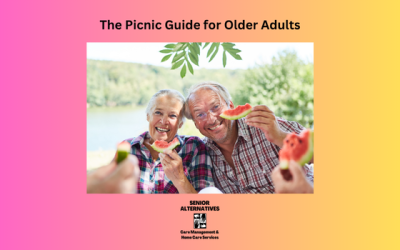January 13, 2021

Getting older means having different nutritional needs. This can make it more difficult to eat the right balance of nutritious foods. For example, you may be less physically active or you may have less interest in food than you did before. These changes can occur so gradually that you may not notice them, especially if you don’t have any in home care or senior assistance. The changes can result from illnesses or accidents, genetic patterns, or social, psychological, and economic factors.
Many older adults need to consume relatively higher amounts of protein than they did when they were younger. This is because of the stress on your body as you age, and a general loss of protein from muscles and internal organs that occurs. Combined with a tendency to become more sedentary, this puts you at risk of deteriorating muscles, compromised mobility, slower recovery from illness and the loss of independence. Depending on your personal situation, you may need to think about home care services. A caregiver is a great person to ensure you are getting proper nutrition and physical activity.
If you have stress or injuries, you may need 50% more protein than usual. However, if you have certain diseases, such as kidney or liver disease, your protein intake should be restricted. In any case, you should discuss your daily protein intake with your healthcare provider before making any major changes. Once you know what’s right for you, hiring care services can ensure that you are getting what you need. Recent research suggests that older adults who consume more protein are less likely to lose the ability to dress themselves, get out of bed, walk up a flight of stairs and more. However, those with reduced functioning can improve with the help of a caregiver and other services for seniors.
While eating an adequate amount of protein is not going to prevent age-associated loss of muscle altogether, not eating enough protein can be an exacerbating factor that causes older adults to lose muscle faster.
Breakfast tends to be the meal where most people lack protein. Some ideas for adding protein include the following:
- Add nuts and seeds to cereal. If you eat cereal, try decreasing the cereal and replacing with nuts or seeds like pumpkin, sunflower, or flax.
- Start with an egg. Eggs are a neat little protein package. For a quick no-cook breakfast, try hard boiling six eggs at a time in advance. Keep in the fridge and grab one for a quick addition to breakfast.
- Make a breakfast bowl. Try a Greek yogurt breakfast bowl. 8 ounces of yogurt could give you 17-20 grams of protein. Throw in a handful of nuts and seeds for even more protein-packed energy.
- Load up on nut butters. Keeping a jar of your favorite nut butter on hand makes adding protein easy. Try a spoonful of peanut, almond, or cashew butter. Be careful to avoid nut butters with added sugars. Eat nut butters on whole grain toast, mixed in your oatmeal, in a shake, on a sweet potato with cinnamon.
- Protein shakes. Protein shakes make a quick and easy protein breakfast. You can use a plant-based or animal-sourced form of protein. Some protein powders will even mix right into your coffee or tea. You want to make sure you use a high-quality protein powder that does not contain salt or sugar.
Some high protein lunch or dinner ideas include these:
- Add Protein to Salads. Salads are a great way to load up on protein and veggies. Add things to create a superfood salad recipe that keeps you full. Try nuts or seeds and eggs or tofu.
- Substitute meat for bread. Instead of going for a sandwich, make a meat roll-up. To make a quick lunch-to-go use a couple slices of thin turkey breast wrapped around cucumber, cheese, and lettuce.
- Top with an egg. Eggs can also be added as egg salad, or just a hardboiled egg along with your regular meal.
- Add beans. Plant-based protein is a quick easy meal. Try a can of rinsed chickpeas mixed with quinoa, fresh parsley, and tomato. Add in some feta cheese for extra “yum” and protein.
- High protein soup. Soup or pureed food is great for seniors who struggle with tough textures. You can slow-cook stews and soups to make meat or beans softer and easier to digest.
If you need any help with obtaining groceries or cooking, remember that hiring a caregiver is a great way to get your needs met!
Many older adults need to consume relatively higher amounts of protein than they did when they were younger. This is because of the stress on your body as you age, and a general loss of protein from muscles and internal organs that occurs. Combined with a tendency to become more sedentary, this puts you at risk of deteriorating muscles, compromised mobility, slower recovery from illness and the loss of independence.
Related Articles
International Self-Care Day 7/24
The date, 7/24 symbolizes the idea that self-care should be practiced 24 hours a day, 7 days a week. It’s a gentle nudge to make self-care a daily priority, not just a once-a-year activity. Read more on ways to create a self-care plan.
Summertime is here, let us help you plan the perfect picnic…
Summertime is a great time to enjoy the outdoors and plan a picnic, the perfect opportunity to bring joy especially for seniors in your life. With a bit of thoughtful preparation, you can create an experience that is both comfortable and memorable. To help you get started, here are some tips and ideas to plan a senior-friendly picnic that prioritizes accessibility, safety, and relaxation.
Boost Cognitive Function Through Brain Exercises
Just like the rest of your body, your brain changes and adapts over time. Through a concept known as neuroplasticity, your brain can form new connections, strengthen existing ones, and even recover lost abilities. Regular mental exercises can have a significant impact on your brain health. Read on to know more…





